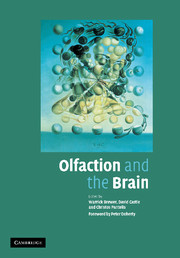Book contents
- Frontmatter
- Contents
- Foreword
- Preface
- List of Contributors
- Section I Neurology, Neurophysiology and Neuropsychology: Olfactory Clues to Brain Development and Disorder
- 1 Structure and Function of the Olfactory System
- 2 Olfaction and the Temporal Lobes
- 3 Role of the Insula in Smell and Disgust
- 4 Olfaction and Memory
- 5 Olfactory Neurogenesis: A Window on Brain Development
- 6 Olfactory Processing and Brain Maturation
- 7 Probes of Behaviour Regulation: Olfactory Models in Addiction
- Section II Social Functioning: Role of Evolution, Genetics and Gender
- Section III Assessment and Disorders of Olfaction
- Index
- Plate section
- References
3 - Role of the Insula in Smell and Disgust
from Section I - Neurology, Neurophysiology and Neuropsychology: Olfactory Clues to Brain Development and Disorder
Published online by Cambridge University Press: 17 August 2009
- Frontmatter
- Contents
- Foreword
- Preface
- List of Contributors
- Section I Neurology, Neurophysiology and Neuropsychology: Olfactory Clues to Brain Development and Disorder
- 1 Structure and Function of the Olfactory System
- 2 Olfaction and the Temporal Lobes
- 3 Role of the Insula in Smell and Disgust
- 4 Olfaction and Memory
- 5 Olfactory Neurogenesis: A Window on Brain Development
- 6 Olfactory Processing and Brain Maturation
- 7 Probes of Behaviour Regulation: Olfactory Models in Addiction
- Section II Social Functioning: Role of Evolution, Genetics and Gender
- Section III Assessment and Disorders of Olfaction
- Index
- Plate section
- References
Summary
Introduction
The emotion of disgust
Disgust is an important emotion, as it is believed to have evolved to protect the individual from danger in the form of harmful substances, including those detected in the olfactory and gustatory modalities. Disgust (literally, ‘bad taste’) has been defined in terms of a food-related emotion. It has been recognised as a basic emotion since Darwin (1872/1998), who wrote that disgust was ‘… something offensive to the taste’. A more recent definition of disgust is offered by Rozin & Fallon (1987): ‘Revulsion at the prospect of (oral) incorporation of an offensive object. The offensive objects are contaminants; that is, if they even briefly contact an acceptable food, they tend to render that food unacceptable’. Sources other than ingestion, such as sex or defence against infection (Rozin et al., 2000) have also been proposed. A different approach to disgust, diverging from its definition based on taste, argues that it is based on the senses of touch and smell and that the taste–disgust association is more recent (Miller, 1997).
Like other emotions, disgust has a characteristic facial expression which is recognised across all cultures as shown in Figure 3.1 (Ekman & Friesen, 1976). This facial expression involves facial muscles necessary for the avoidance of ingestion of contaminants and consists of the closing of the nostrils and opening of the mouth. Features of this facial expression appear to be innate, as nose wrinkling and upper lip raising can be observed in neonates.
- Type
- Chapter
- Information
- Olfaction and the Brain , pp. 50 - 64Publisher: Cambridge University PressPrint publication year: 2006
References
- 3
- Cited by

